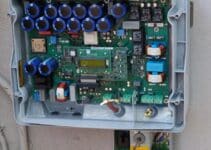South Korean scientists have developed a WD-ER cooling system that can lower the operating temperature of a PV panel by up to 14.9 C, with an average heat transfer coefficient of 64.1 W/m2.
Image: Korea University, nature communications, Creative Commons License CC BY 4.0
A research team at Korea University has created a passive cooling system for solar panels that uses a water desorption process and endothermic reaction dissolution process.
The method is similar to phase change materials (PCMs), which absorb, store and release a large amount of latent heat over a specified temperature range, and are typically used for PV module cooling at the research level. The system is inexpensive and does not consume energy, and it has self-recovering properties, making it highly versatile.
“The proposed method has no energy consumption and consists of cheap materials, making it highly applicable,” the scientists claimed. “Moreover, it can be repeatedly utilized, owing to its self-recovering characteristics.”
The researchers describe the technique as an atmospheric water desorption-driven cooling system that uses Zeolite 13X, a commercially available alumino-silicate material, to desorb water molecules that produce a latent cooling effect. When heat is applied, water is desorbed from Zeolite 13X and dissolves ammonium nitrate (NxH4NO3) to induce endothermic reaction cooling, resulting in a reversible process that recovers itself at night.
The water desorption-driven endothermic reaction (WD-ER) cooling system can absorb heat from solar radiation and desorb the solvent, which generates secondary cold energy by dissolving the solute. The cooling effect is achieved because the water adsorption capacity of zeolite 13X is inversely proportional to temperature, and water can dissolve more ammonium nitrate at higher temperatures.
The Korean team attached the WD-ER system to the backside of a solar cell that is urethane waterproofed to protect it from moisture. They coated the cell with Zeolite 13X particles and a negligible amount of polyvinyl, then saturated these particles with water and added an NH4NO3 crystal layer to form a thin film.
The WD-ER system had an average effective heat transfer coefficient of 64.1 W/m2, and thermal imaging taken at 2 pm showed that the surface temperature of the PV cell with the WD-ER cooling unit was 39–43 C, which was significantly lower than that of natural air cooling (51–56 C). The average temperature of the PV cell with WD-ER was reduced by 14.9 C.
The researchers suggest that this novel cooling system may outperform other cooling methods reported in the literature, although they did not provide a detailed analysis of production costs or potential commercial applications.
They presented their findings in “Self-recovering passive cooling utilizing endothermic reaction of NH4NO3/H2O driven by water sorption for photovoltaic cell,” which was recently published in Nature Communications.
This content is protected by copyright and may not be reused. If you want to cooperate with us and would like to reuse some of our content, please contact: [email protected].


